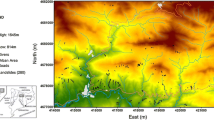Abstract
This paper presents a GIS-aided procedure for shallow landslide susceptibility mapping at a regional scale. Most of the input data for the susceptibility assessment have been captured automatically. A total of 13 parameters, related to the slope geometry, have been derived from the digital elevation model (DEM) while vegetation cover and thickness of superficial formations have been obtained from photointerpretation and field work. The susceptibility assessment is based on multivariate statistical techniques (discriminant analysis), which hasbeen tested in a pilot area in La Pobla de Lillet (Eastern Pyreenes, Spain). Theresults obtained using a random sample show that 82% of all the cells, and 90% of cells including slope failures, have been properly classified. A susceptibility map based on the discriminant function has given consistent results. The susceptibilityassessment is very sensitive to the parameters selected. Compared to thetraditional methods, the main advantage of the GIS-aided procedure is the rapidityprovided by the automatic capture of parameters. It also has the capability of coveringlarge areas, and the objectivity and reproducibility of the results. The main drawbackis that, at present, not all regions have DEM accurate enough to cope with small landslides.
Similar content being viewed by others
References
Baeza, C.: 1994, 'Evaluación de las condiciones de rotura y de la movilidad de los deslizamientos superficiales mediante el uso de técnicas de anàlisis multivariante, Ph.D. thesis, Technical University of Catalonia, Barcelona. Unpublished.
Baeza, C. and Corominas, J.: 2001, Assessment of shallow landslide susceptibility by means of multivariate statistical techniques, Earth Surface Processes and Landforms 26: 1251–1263.
Brabb, E. E.: 1984, Innovative approaches to landslide hazard and risk mapping, IV International Symposium on Landslides, Vol. 1, Toronto, pp. 307–323.
Carrara, A.: 1983. Multivariate models for landslide hazard evaluation, Mathematical Geology 15(3), 403–426.
Carrara, A. Catalano, E., Sorriso-Valvo, M., Reali, C., and Osso, I.: 1978. Digital terrain analysis for land evaluation, Geologia Applicata e Idrogeologia 13, 69–127.
Carrara, A., Cardinali, M., Guzzetti, F., and Reichenbach, P.: 1995, GIS technology in mapping landslide hazard, In: A. Carrara and F. Guzzetti (eds), Geographical Information Systems in Assessing Natural Hazards, Kluwer Academic Publishers, pp. 135–175.
Cruden, D. M. and Varnes, D. J.: 1996, Landslide types and processes', In: A. K. Turner and R. L. Schuster (eds), Landslides: Investigation and Mitigation, TRB Special Report, 247, National Academy Press, Washington, pp. 36–75.
Dillon, W. R. and Goldstein, M.: 1986, Multivariate Analysis. Methods and Applications, JohnWiley and Sons Ltd., 565 pp.
Gallart, F. and Clotet, N.: 1988, Some aspects of the geomorphic processes triggered by an extreme rainfall event: The November 1982 flood in the Eastern Pyrenees, Catena Supplement 13, 79–95.
Greenway, D. R.: 1987, 'Vegetation and slope stability', In: Anderson and Richards (eds), Slope Stability, John Wiley & Sons, pp. 187–231.
Jones, F. O., Embody, D. R., and Peterson, W. C.: 1961, Landslides along the Columbia river valley, Northeastern Washington, U.S. Geological Survey Professional Paper 367, 1–98.
Mu\(\ddot n\)oz, J. A., Martínez, A., and Vergés, J.: 1986, Thrust sequences in the Spanish Eastern Pyrenees, Journal of Structural Geology 8, 399–405.
Neuland, H.: 1976, A prediction model of landslips', Catena 3, 215–230.
Nilsen, T. H. Wright, R. H. Vlasic, T. C., and Spangle, W. E.: 1979, Relative slope stability and landuse planning in the San Francisco Bay region, California, U.S. Geological Survey Professional Paper 944, 96 pp.
Reneau, S. L. and Dietrich, W. E.: 1987, The importance of hollows in debris flow studies; examples from Martin County, California, Geological Society of America, Reviews in Engineering Geology VII, 165–180.
Oyagi, N.: 1984, Landslides in weathered rocks and residuals soils in Japan an surrounding areas: state-of-the-art report, 4th International Symposium on Landslides, Vol. 3, Toronto, pp. 1–31.
Santacana, N.: 2001, Análisis de susceptibilidad del terreno a la formación de deslizamientos superficiales y grandes deslizamientos mediante el uso de Sistemas de Información Geográfica. Aplicación a la cuenca alta del Río Llobregat, Ph.D. thesis, Technical University of Catalonia, Barcelona. http://www.tdcat.cesca.es/TDCat-0713101-113341/
Van Westen, C. J.: 1994, GIS in landslide hazard zonation: A review, with examples from the Andes of Colombia, In: M. F. Price & D. I. Heywood (eds), Mountain Environments and Geographic Information Systems, Taylor and Francis Publishers, pp. 135–165.
Author information
Authors and Affiliations
Rights and permissions
About this article
Cite this article
Santacana, N., Baeza, B., Corominas, J. et al. A GIS-Based Multivariate Statistical Analysis for Shallow Landslide Susceptibility Mapping in La Pobla de Lillet Area (Eastern Pyrenees, Spain). Natural Hazards 30, 281–295 (2003). https://doi.org/10.1023/B:NHAZ.0000007169.28860.80
Issue Date:
DOI: https://doi.org/10.1023/B:NHAZ.0000007169.28860.80




